Prilepin’s Chart Guide: Optimize Your Lifts
Author:
Reviewed by:
(21 years of Oly Lifting experience)
Unlock your full potential by engaging with our experts and community! Have questions about your fitness journey or looking for expert advice on weightlifting techniques? Don’t hesitate — leave a comment below and Ihor Shymechko will provide a personalized answer and insights to help you reach your goals.
Torokhtiy is reader-supported. Some links are affiliate links, and we may earn a commission at no extra cost to you. See our disclosure page for details.
When it comes to optimizing your strength training routine, Prilepin`s chart is a tool you shouldn’t overlook. Originating from the world of weightlifting this sets and reps chart was developed by Soviet weightlifting coach Alexander Prilepin.
It offers a structured approach to balancing volume and intensity in your workouts. You achieve maximum gains without overtraining whether you are powerlifter, weightlifter or just serious about your strength training, understanding and implementing Prilepin`s chart can significantly enhance your training outcomes.
Prilepin’s chart is a training tool that helps athletes determine the optimal number of sets and reps for different intensity in workouts. Developed by Soviet weightlifting coach Alexander Prilepin, Prilepin’s chart ensures effective volume and intensity management to maximize strength gains.
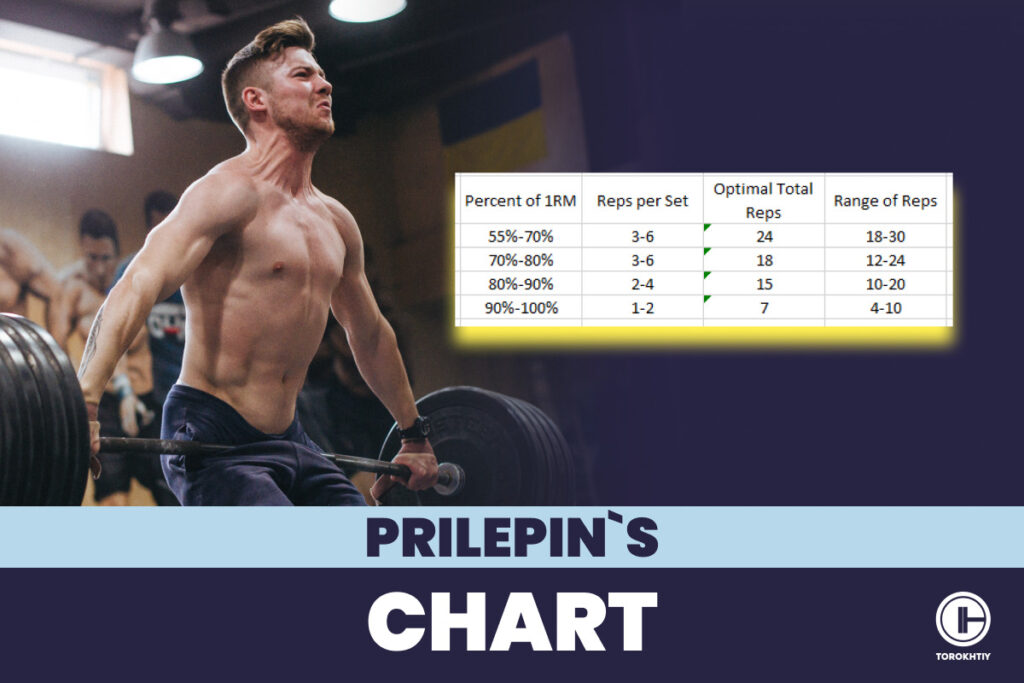
In this article, we will delve into the details of this weightlifting rep charts. You will learn about its components, the science behind it and how to effectively use it in your training routine.
We will also discuss the benefits and limitations of this powerful tool, providing you with the comprehensive guide to mastering your strength training. Get ready to unlock your full potential.
Prilepin’s Chart – What is it and For Who?
Prilepin’s chart is a foundational tool in strength training, particularly for weightlifting and powerlifting. It was developed in the period of 1960-70 by PhD Alexander Prilepin, a Soviet Olympic weightlifting coach, who based this chart on his observations of weightlifting sessions.
From 1975 to 1980, he was the head coach of the USSR youth national team, and from 1980 to 1985, he led the coaching staff of the senior USSR team. Under his leadership, the team won 8 medals at the 1980 Moscow Olympics and 30 medals at the World Championships from 1981 to 1983.
The chart`s principles are straightforward: it categorizes intensity into percentages of athlete`s one rep max (1RM) and provides recommended ranges for total repetitions and sets within those intensity zones.
For example, lifting at 70-80% of your 1RM suggests 18-30 total reps across 3-6 sets. This structured approach helps athletes manage training volume and intensity effectively.
Prilepin’s chart for powerlifting and weightlifting is beneficial for athletes at various levels, from beginners to advanced lifters. It ensures that training sessions are productive, balancing the need for sufficient volume to stimulate muscle growth and strength without leading into overtraining or injury.
By following prilepin’s table for weightlifting athletes can systematically progress in their strength training, ensuring steady gains and improving performance.
1. Components of Prilepin’s Chart
| Percent of 1RM | Reps per Set | Optimal Total Reps | Range of Reps |
|---|---|---|---|
| 55%-65% | 3-6 | 24 | 18-30 |
| 70%-80% | 3-6 | 18 | 12-24 |
| 80%-90% | 2-4 | 15 | 10-20 |
| 90% | 1-2 | 7 | 4-10 |
Prilepin’s chart is divided into several components, each designed to optimize training, efficiency, and effectiveness. The chart primarily focuses on the relationship between intensity, measured as percentage of athlete`s 1RM and the ideal number of reps and sets within that intensity range.
The chart categorizes intensity into different percentages of 1RM. For instance, it might at list ranges like 55-65%, 70-80%, 80-90% and 90%+.
For each intensity range chart suggests a specific number of total repetitions. For example, lifting at 55-65% intensity might recommend 24-30 total reps, while 70-80% might suggest 18-24 total reps.
Within each intensity range, the chart also provides guidance on the number of sets to perform. This ensures that the total number of reps is distributed in a way that balances workload and recovery. For example, the 70-80% range might recommend 3-6 sets.
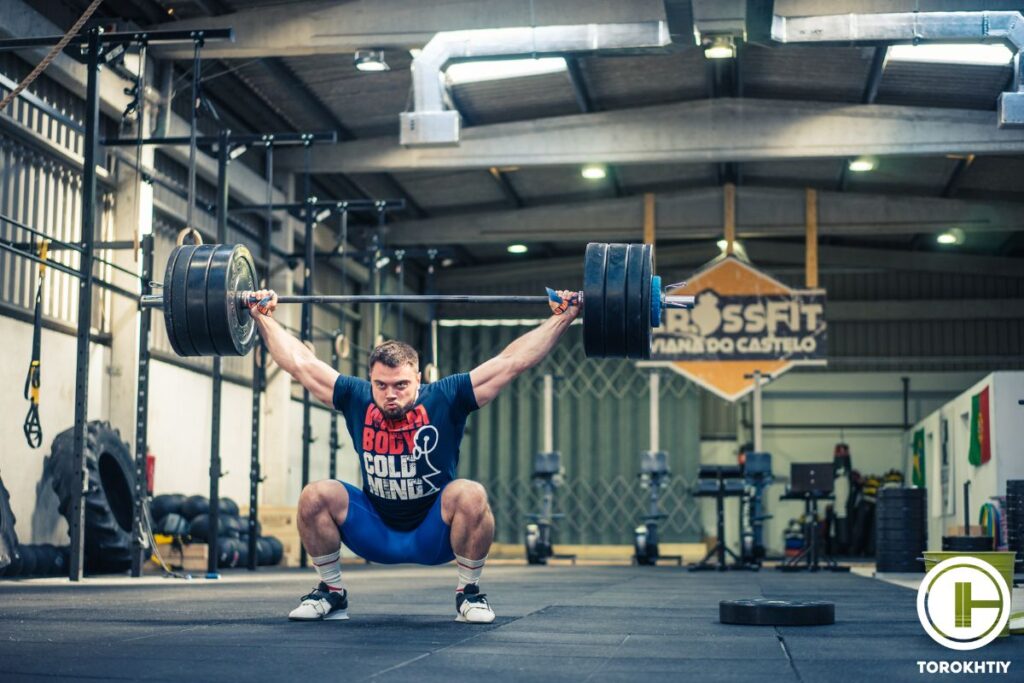
By following this structured approach, athletes can ensure their training is both effective and safe. Prilepin’s chart is an invaluable tool in sets and reps charts and weightlifting rep charts, guiding athletes to optimize their performance and achieve their training goals efficiently.
2. The Science Behind Prilepin’s Chart
Prilepin’s chart is grounded in extensive research and empirical data collected from the elite with lifting training sessions. Alexander Prilepin analyzed thousands of workouts to develop a set of guidelines that optimize training effectiveness.
The chart`s recommendations are based on the observed performance and recovery patterns of highly trained athletes. It is important to add, that all classical Soviet strength scientists, such as Prilepin, Zatsiorsky, Medvedev and Verkhoshansky made their research on not only thousands of guys (huge sample) but also all of them were high level athletes.
It makes a huge difference as today we see studies with sample size up to 20 folks if we are lucky but also most of the time they are recreational athletes. Improving strength in recreational athletes vs high level are two separate things. This makes their work extremely good and valuable.
Prilepin identified specific intensity ranges and the corresponding optimal number of reps and sets that produced the best results. This balance between volume and intensity is crucial for maximizing gains and minimizing fatigue and risk.
Scientific studies have validated the principles behind Prilepin’s chart. Research shows that training within the recommended intensity and volume ranges promotes neural adaptations, muscle hypertrophy and strength development.
The chart`s structure helps athletes manage their training load effectively, allowing for consistent progress overtime.
3 Benefits of Using Prilepin’s Chart
Using Prilepin’s chart in your training offers several advantages. This scientifically backed tool helps at least optimize their workouts for maximum gains while preventing overtraining and injuries.
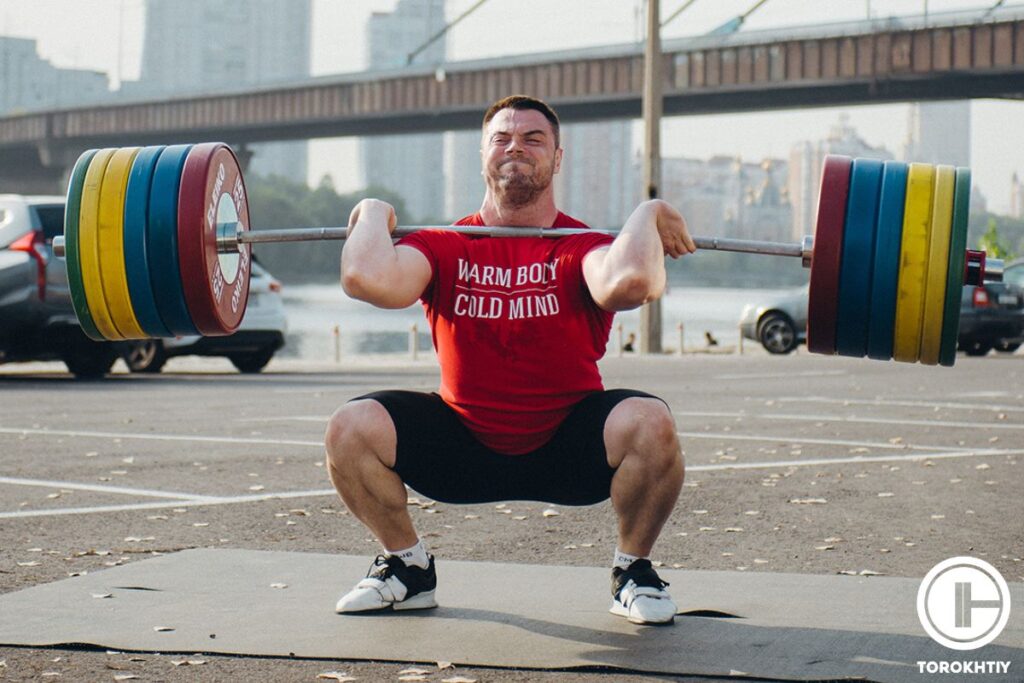
✅ Consistency in Progress
Following preference charts table allows for a structured approach in training. Consistency is key to making steady progress overtime, as it ensures that athletes are continually challenging their muscles in a manageable way.
✅ Reduced Injury Risk
Proper volume and intensity management reduces the risk of overuse injuries. By adhering to the recommended, rap and set ranges athletes can maintain hyper performance level while minimizing the chances of burnout and injury.
✅ Volume and Intensity Management
Prilepin’s chart provides specific guidelines on the optimal number of reps and sets for different intensity levels. This ensures that athletes get enough volume to stimulate strength growth without excessive fatigue.
By categorizing intensity into different ranges based on athletes 1RM, the chart helps in balancing workout intensity. This prevents athletes from lifting to light, which might not stimulate growth or too heavy, which could increase the risk of injury.
How to Use Prilepin’s Chart in Training?
Incorporating Prilepin’s chart into your training routine, can significantly enhance your strength and overall performance. Here’s a practical guide to help you get started.
1. Determine your 1RM
First find your one-rep max for the exercises you plan to use the chart with such as squats, snatches or C&J, etc. This is the maximum weight you can lift for a single repetition with proper form.
Rep Max Calculator
| RM | Average | % |
|---|
2. Plan Your Workouts
Structure your training sessions based on the chart`s recommendations. Ensure you are hitting the target rep range without exceeding it, as it helps manage fatigue and maintain high performance. For example, you might plan to do 4 sets of 5 reps if you are targeting 20 total reps in the 70-80% range.
3. Adjust as Needed
Listen to your body and adjust your training as necessary. If you are consistently struggling to complete, the recommended sets and reps consider lowering the intensity or reducing the volume slightly.
4. Track Progress
Keep detailed records of your workouts, including weights used, sets, reps and any notes on how you felt during the session. This helps you monitor progress and make informed adjustments overtime.

4. Volume (Sets and Reps)
Using to determine the appropriate number of reps and sets involves understanding the relationship between intensity and volume. Here’s how you can apply the chart to your training:
● Consult the Sets and Reps Chart
Chart provides guidelines for optimal number of total reps within each intensity range for the 70-80 percent range. The chart might recommend a total of 18-24 reps.
● Distribute Reps Across Sets
Once you know the total reps, distribute them across a number of sets. The chart provides a range of sets to choose from. For example, 3-6 sets might be suggested for a 70-80% intensity range. Typical approach could be 4 sets of 5 reps, which equals 20 reps, fitting within the recommended range.
● Adjust Based on Performance
Start with the middle of the recommended range and adjust based on how your body responds. If you find the volume too texting, you might reduce the number of sets or slightly. Conversely, if it feels too easy, you can consider increasing within the recommended range.
5. Intensity
Managing training intensity with Prilepin’s chart involves selecting the appropriate load, range and adjusting your training accordingly. Here’s how you can effectively use the chart to manage your workout intensity:
● Choose the Intensity Range
Based on your training goals, select the intensity range from Prilepin’s chart. It categorizes intensity into different percentages of your 1RM, such as 55-65%, 70-80%, 80-90%, 90+%.
● Adjust Training Load
Begin your training with the lower and of the recommended intensity range and gradually increase as your strength and power improve. This allows your body to adapt without risk, overtrading or injury.
By following these steps, you can effectively manage your training intensity, using Prilepin’s chart, ensuring that your workouts are both challenging and safe leading to consistent strength gains.
Considerations and Limitations
While chart is a valuable tool for optimizing strength training, there are several considerations and limitations to keep in mind to ensure it works effectively for you.
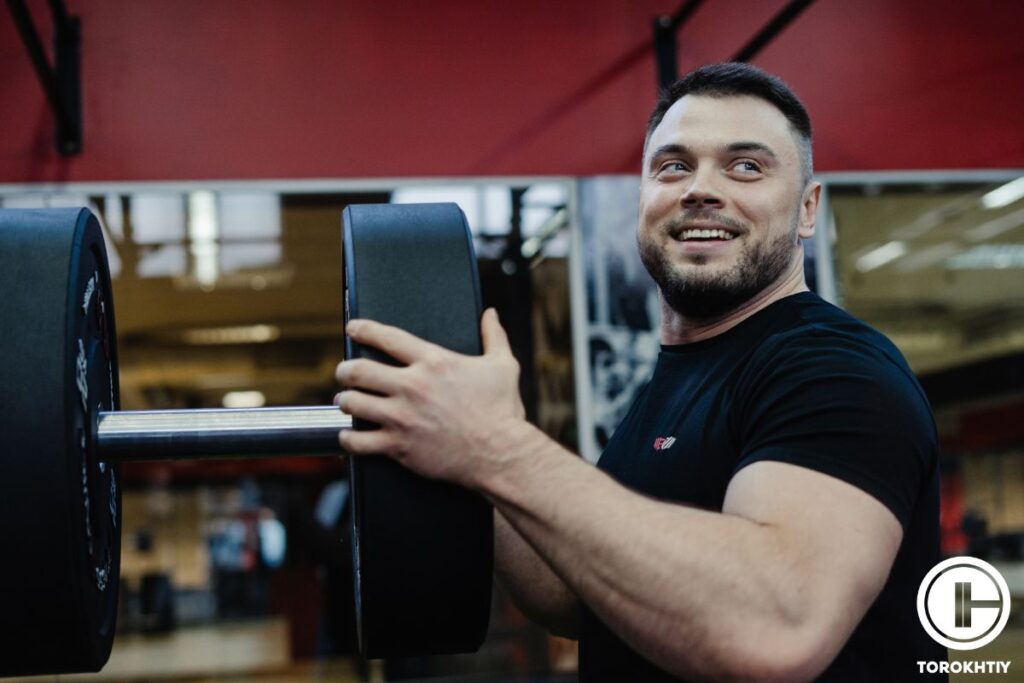
1. Specificity of Goals
Prilepin’s chart is primarily designed for Olympic weightlifting and powerlifting. Athletes with different goals, such as hypertrophy, endurance or sports specific training, may need to modify the chart`s guidelines to better suit their needs.
The recommended sets and reps for maximum strength might not align with the volume needed for other training outcomes.
2. Adaptation and Plateaus
Overtime, your body adapts to the stimulus provided by Prilepin’s chart. This can lead to plateaus, if training parameters are not periodically adjusted.
It’s important to vary your training phases, incorporate different exercises and occasionally step outside the chart`s recommendations to keep your workout challenging and effective.
3. Recovery and Overtraining
Following Prilepin’s table without considering your personal recovery capacity can lead to overtraining. Ensure you are getting adequate nutrition and sleep to support your training. Monitoring your fatigue levels and adjusting training as necessary is key to prevent burnout and injuries.
4. Individual Variability
Every athlete is unique with different genetic dispositions, muscle fiber compositions and recovery rates. What works for one person might not work for another.
For instance, an athlete with higher percentage of fast-twitch muscle fibers might respond better to lower rep ranges at higher intensities, while someone with more slow-twitch fibers might thrive with higher volume.
5. Training Level
Your level of experience in strength training will also dictate how you should use Prilepin’s chart. Beginners often need more basic straightforward programs to build a solid foundation of strength and technique.
For them, detailed recommendations of chart might be too advanced and could potentially lead to overtraining if not adjusted properly. On the other hand, intermediate and advanced lifters, who have already developed a significant base of strength, can benefit greatly from charts, structured approach for optimizing volume and intensity.
FAQ
Is Prilepin’s Chart Good?
Yes, Prilepin’s chart is a highly regarded tool in strength training. It helps lifters optimize their workouts by providing scientifically-backed guidelines for sets and reps at various intensity levels. This ensures effective volume and intensity management leading to better strength gains and reduced risk of overtraining.
What Are The Optimal Reps For Prilepin’s?
The optimal reps, according to Prilepin’s chart, vary by intensity. For example, at 70-80% of your one rep max (1 RM), 18-24 reps are recommended, typically spread across 3-6 sets. These ranges ensure effective training stimulus, while preventing excessive fatigue and injury.
Conclusion
In summary Prilepin’s chart is an invaluable tool for strength training, offering guidelines for managing volume and intensity. By understanding its principles and applying them to your workouts, you can optimize your training for strength gains while minimizing the risk of overtraining.
Whether you are a novice or advanced lifter, tailoring the chart to your individual needs and training level is key to maximizing its benefits. Have you used Prilepin’s chart in your training? Share your experiences in the comments below – we would love to hear how it worked for you.
Also Read:
- Deadlift Sets And Reps Explained
- How To Get Bigger Wrists: Growth Strategies & Exercises
- Front Squat Grip Secrets – Techniques & Tips
- Front Rack Mobility: How to Test and Improve
- Can You Squat Every Day Safely?
References:
- Zatsiorsky, V. M., & Kraemer, W. J. (2006). Science and Practice of Strength Training
- Baker, D., Wilson, G., & Carlyon, B. (1994). Periodization: The effect on strength of manipulating volume and intensity. Journal of Strength and Conditioning Research, 8(4), 235-242.
- Haff, G. G., & Nimphius, S. (2012). Training Principles for Power. Strength and Conditioning Journal, 34(6), 2-12.
- Peitz M, Behringer M, Granacher U. A systematic review on the effects of resistance and plyometric training on physical fitness in youth- What do comparative studies tell us? PLoS One. 2018 Oct 10;13(10):e0205525. doi: 10.1371/journal.pone.0205525. Erratum in: PLoS One. 2018 Nov 14;13(11):e0207641. PMID: 30304033; PMCID: PMC6179270.
- Larsen S, Kristiansen E, van den Tillaar R. Effects of subjective and objective autoregulation methods for intensity and volume on enhancing maximal strength during resistance-training interventions: a systematic review. PeerJ. 2021 Jan 12;9:e10663. doi: 10.7717/peerj.10663. PMID: 33520457; PMCID: PMC7810043.
- Moesgaard, L., Beck, M.M., Christiansen, L. et al. Effects of Periodization on Strength and Muscle Hypertrophy in Volume-Equated Resistance Training Programs: A Systematic Review and Meta-analysis. Sports Med 52, 1647–1666 (2022). https://doi.org/10.1007/s40279-021-01636-1
- Photos made by Torokhtiy Media Team; skenester (canva.com)
Why Trust Us?
With over 20 years in Olympic weightlifting, strength training, nutrition coaching, and general fitness our team does its best to provide the audience with ultimate support and meet the needs and requirements of advanced athletes and professional lifters, as well as people who strive to open new opportunities and develop their physical capabilities with us.
By trusting the recommendations of our certified experts in coaching, nutrition, and sports training programming, as well as scientific consultants, and physiotherapists, we provide you with thorough, well-considered, and scientifically proven content. All the information given in the articles concerning workout programming, separate exercises, and athletic performance, in general, is based on verified data.
The product testing process is described in more detail here.
Author: Ihor Shymechko
Pro Olympic Weightlifter, Coach
Best Results: Snatch – 208 kg,
C&J – 240 kg
Ihor has been a professional weightlifter since 1996, boasting over two decades of competition experience. His notable achievements include clinching the European Championship in 2009 and securing a silver medal in the 105kg division at the Senior World Championships in 2011. Ihor represented his country in the 2008, 2012, and 2016 Summer Olympics. After retiring from competitive weightlifting, he transitioned to coaching, leveraging his vast experience to guide athletes who now compete on both national and international stages.
Reviewed by: Oleksiy Torokhtiy
Olympic Weightlifting Champion, PhD in Sport Science
Best Results: Snatch – 200 kg,
C&J – 240 kg
Oleksiy Torokhtiy is a professional athlete boasting 20 years of experience in Olympic weightlifting. With multiple European and World titles under his belt, he has showcased his prowess in two Olympic Games (Beijing 2008 and London 2012). Upon concluding his illustrious career, Oleksiy dedicated himself to coaching. By 2022, he had conducted over 200 weightlifting seminars worldwide. He is the visionary behind an international sportswear and accessories brand known for its motto, “Warm Body Cold Mind.” Additionally, he is an esteemed author and the creator of a series of training programs and eBooks.




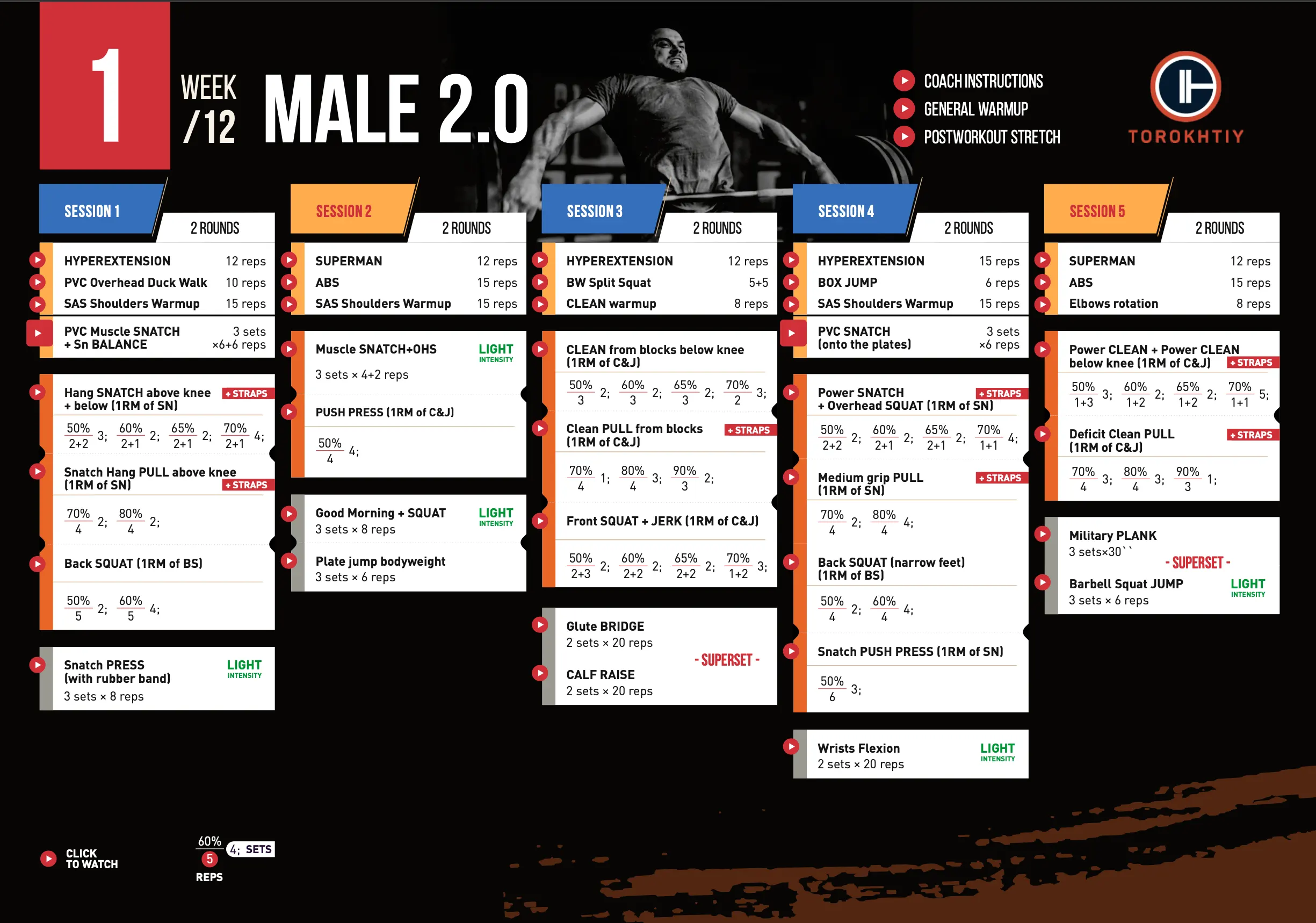
Still have questions after reading our article? Unlock your full potential by engaging with our experts and community! Don’t hesitate — leave a comment below and Ihor Shymechko will provide a personalized answer and insights to help you reach your goals.